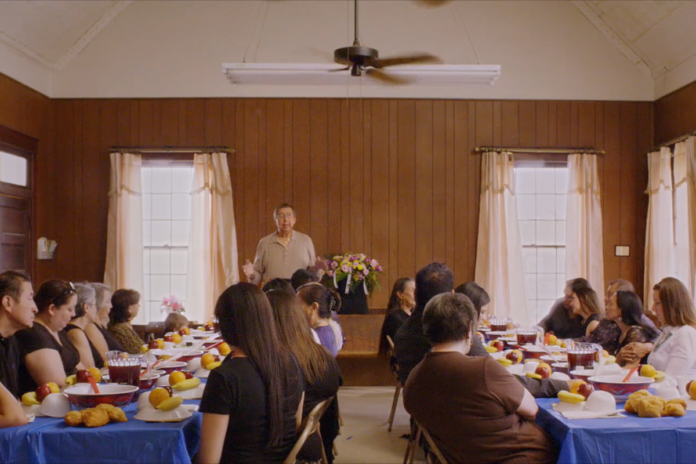When the Academy Awards ignored Killers of the Flower Moon in all the categories where it had been nominated, Osages turned to what matters most to us. At the Oscar awards ceremony, Scott George and the Osage Tribal Singers sang “Wahzhazhe (A Song for My People),” while Drumkeepers and dancers from each district danced. The drum, words of the song, and the sound of the bells wrapped around us and lifted our hearts like they do at each Inlonshka.
It was touching for Osages and Natives watching, for the audience at the awards ceremony who stood and burst into thunderous applause, “with tears streaming down their faces,” lady singer Julia Lookout observed. As singers and dancers returned from Los Angeles, they were celebrated by family and friends wanting to welcome them and hear what it was like. Scott and Taveah George posed with friends by a life-size mural of characters from the film at the new Saucy Calf restaurant.
For traditional singers, the Hollywood stage was unexpected. “I never thought I’d be here,” Lookout said. “I’ve had a great life, but I never expected this.”
“It was a surreal,” Lookout said. The singers traveled to New York, and LA more than once promoting the film. Lookout has grown up around the drum, her father Morris Lookout was head singer for all three districts, who mentored Scott George.
For Jacque Jones, the great-great-granddaughter of Henry Roan, murdered in the Reign of Terror, KOTFM brought mixed feelings. “To start out, it was pretty touchy. I didn’t try out for a part.” When she was approached to sing for the movie, she prayed, then decided it was meant to be. “I’m a traditional, cultural singer, I don’t consider myself a performer. None of us do.”
“To be on the Oscars stage was overwhelming, humbling, all the emotions,” Jones said. “I haven’t wrapped my head around what we just did. It felt really good to hear people open to hear us, see us.”
Jones’s mother, Mary Bighorse was a well-loved singer. We remember her wearing her sunglasses as she sang around the drum. Jones felt her mother with her on the stage. She was dressed by her family. She wore a beaded broadcloth skirt and earrings made by her daughter, and a shirt from sister Dana Daylight, and best, she wore her mother’s moccasins.
As the intense focus on Killers of the Flower Moon and the Academy moves into a new phase, a new independent film, written and directed by Diane Fraher was released on demand on March 26. Fraher is an enrolled member of the Osage Nation with documented Cherokee heritage. The Heart Stays is an independent film, produced by Fraher’s company Amerinda. The coming-of-age story focuses on Shannon Ki-he-ke-zhe, eldest daughter in a traditional Osage family. Cast includes Delanna Studi as Shannon’s mother, Jon Proudstar (recently of Reservation Dogs) as her father, and Casey Camp-Horinek as her grandmother. This film feels like Oklahoma, like the Osage.
The film opens at a funeral in the Pawhuska Cemetery with a recognizable Osage voice addressing mourners, translating and then inviting them to 𐓏𐒰𐓁𐓂͘𐒴𐒷 𐒼𐓎. The camera pans to reveal Billie Sam Fletcher addressing the group with Rick Luttrell by his side. It was important to Fraher to have an elder who spoke reflecting the Osage he heard from Osages born before 1900s. Cecelia Tallchief and Rosemary Woods are among the mourners, and Louis Gray is roadman. The funeral dinner moves to the Hominy Friends Meeting where Donna Barrone is helping serve the funeral meal.
This is Fraher’s third film, a labor of love that means to demonstrate a model for Native filmmaking by centering a particular tribal community, by having Natives involved in all aspects of production, as actors, behind the camera, etc. Fraher used Native musicians for the sound track, which feels unobtrusive and effective. Fraher says she is grounded in the Osage community, that she and her Osage and Cherokee husband, who is on the Hominy committee, have come home for the Inlonshka and Native American Church Meetings at Barnsdall for decades.
The film has a leisurely pace, the viewer watches the family at dinner, the conflicts that simmer. Fraher chose the pace to reflect how she perceives traditional Osage family dynamics. Ironically, for me it felt more quiet than Osage families, gatherings I’ve been part of. The elder daughter wants to be a writer to tell Osage stories. When she gets a scholarship to a college in the east, her father is opposed. Younger sister (Sierra Kihega) wants to be a singer and a Canadian scout offers opportunity.
The power of the story is in the extended family dynamics, tension between sisters, the bond between aunt and daughter. Osage words are part of the characters’ lives. The film is shot in the Osage and the college scenes in NYC. My favorite scene (besides the Friends Meeting House) is being dropped into an aisle at the IGA in Pawhuska. Fraher chose not to dress the sets, but lets them reflect the community.
It’s a gift to have another film centered in the Osage so close on the heels of KOTFM. Native producers and directors have an uphill battle getting attention and resources. Unlike the $200 million budget KOTFM commanded, Fraher made a “low medium budget” film per the SAG actors payroll service, she said, relishing the way she was able to create the film with grants from the Osage Nation Foundation, and other nonprofits supporting individual artists in New York State. The Heart Stays is a powerful testament to one Osage woman’s commitment. The film was released in NYC, LA, and Tiburon in March, and is now available on demand. It’s definitely worth watching, for another interpretation of Osage life. Fraher is working on another project, and hopes this film offers a model for other Osage and Native filmmakers.



